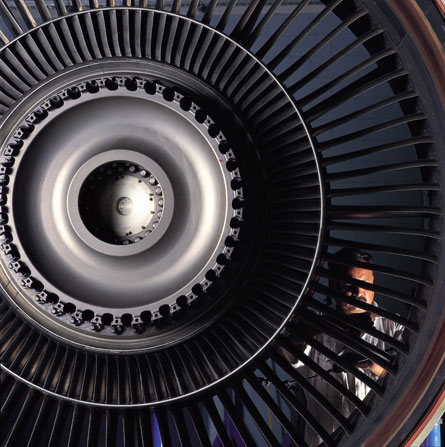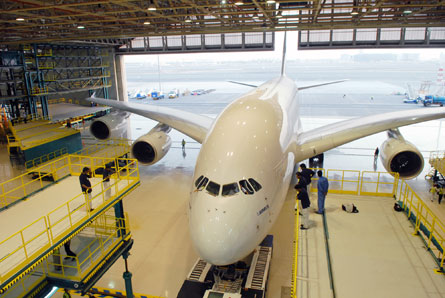Middle Eastern MRO companies need overseas talent to keep their growing airline clients flying. Even though maintenance providers in the Arabian Gulf have begun increasing the proportion of staff hired locally, they continue to depend on expatriates from around the world to support the demand from burgeoning airlines in the region.
The Middle East's commercial aircraft fleet is set to double over the next decade, but maintenance companies also want to attract business from other regions as well as their home market. Assuming 17-20 technicians per aircraft, Egyptair Maintenance & Engineering chief executive Abd El Azis Fadel estimates that 25,000 certified aircraft maintenance employees will be needed across the region over the next five years.
"Little time is required to buy aircraft, but a lot is required to build MRO facilities," says Fadel. "Even more time is required to build experience. So expansion is a challenge."
While airlines and maintenance companies in populous countries such as Egypt can train more local staff, their counterparts in the much smaller Gulf states also have to look beyond their borders to recruit talent. Firms such as Abu Dhabi Aircraft Technologies (ADAT) and Dubai's Emirates Engineering are trying to increase their local staff numbers, but most of their employees still come from abroad.
Middle Eastern airlines are "desperate" for maintenance staff, says Ahmad Al Ali, senior vice-president at Emirates Aviation College, the airline group's commercial training campus in Dubai. "They would even go down to people with [non-vocational] national or higher national diplomas in aerospace engineering and then train them further."
 |
|---|
©EmiratesMiddle East airlines are "desperate for maintenance staff" |
Emirates Engineering plans to recruit about 160 maintenance staff in 2011 and 2012, comprising licensed and unlicensed technicians as well as trainees from all around the world. The company has about 3,800 employees, 15-20% of whom are local.
The need for expatriate staff is reflected in the firm's training activities for aspiring aircraft technicians. It recruits mainly young Emiratis for its in-house maintenance training programme, while its sister, Emirates Aviation College, concentrates on equivalent classes for expatriates. However, Emirates Engineering has also started two training schemes for overseas students over the past four years.
Fleet expansion is one growth driver. According to Flightglobal's ACAS database, Emirates currently has 153 aircraft in service and 217 on firm order. The airline's ambition to offer the "latest and greatest" in cabin interior amenities across its fleet is another driver for continuous cabin refurbishment and retrofit programmes. Its MRO arm, Emirates Engineering, plans to build additional hangars over the next three years and expand its component and engine overhaul capabilities.
Although there is "certain" growth in the workforce, it is not on a large scale, says Iain Lachlan, senior vice-president of aircraft maintenance. "I see an increase of people coming in from external [companies], but not that much mobility out," he says. Thanks to "large interest" from such applicants, the MRO provider runs induction courses for new, qualified recruits every two weeks, he adds.
Over in Abu Dhabi, ADAT plans to recruit about 600 new, qualified staff members this year to add to its 2,100-strong workforce, nearly all of whom are expatriates. Further growth is planned in future years depending on "business needs", the company says.
Recruitment will cover all levels of seniority, from maintenance technician to manager positions, with new staff joining from all over the world. Although the share of Emirati national employees will rise from the current 5% to 30% by 2013, it is clear that most future staff members will still be expatriates.
"Many people stay here 15 to 20 years," says ADAT chief executive Jeremy Chan, "because they are excited about the growth opportunities." The firm is building a $150 million overhaul shop for General Electric GE90, GEnx and Engine Alliance GP7200 powerplants. It also plans a joint-venture landing gear repair facility with Honeywell and an $800 million military MRO facility with Lockheed Martin and Sikorsky at Al Ain airport.
 |
|---|
©EmiratesAdditions to fleets, such as the A380, are driving need for maintenance professionals |
"As with any multicultural company, there are some challenges posed when employing people from different backgrounds," says Chan. "But ADAT's HR [human resource] support of its staff and high standard of training means this is not an issue."
Recent political upheaval in the Middle East will not have a lasting impact on airline growth and job opportunities, says Emirates Aviation College's Ahmad Al Ali. Although Egyptair considered making 25 aircraft available for short-term wet lease - about one-third of its fleet - in an attempt to cut capacity, he believes the buoyant market conditions from before the political crisis will return soon. "We expect that once the governments settle down in Egypt, Tunisia or now Libya, the demand will only increase," he says.
Source: Flight International























